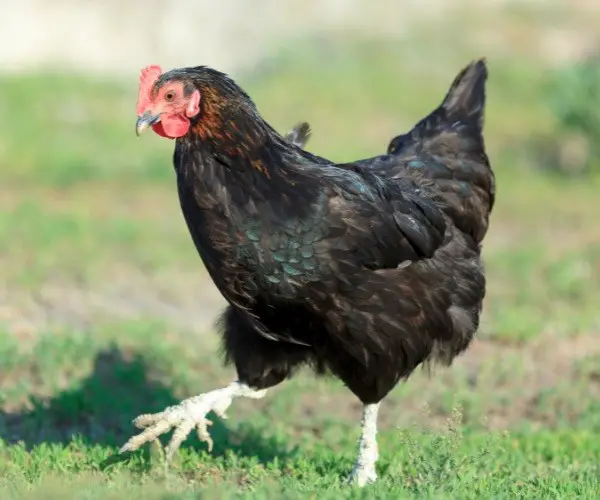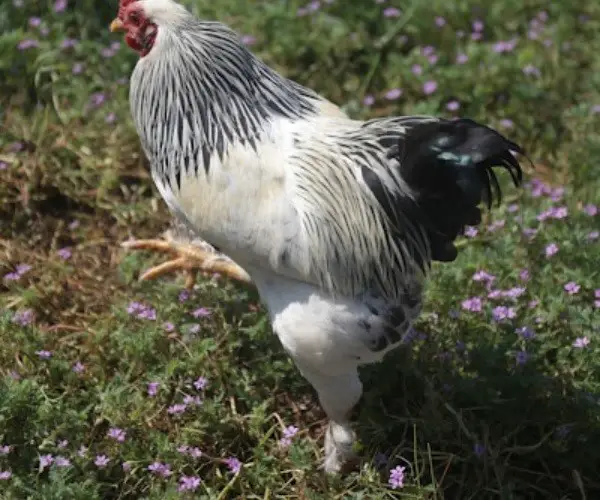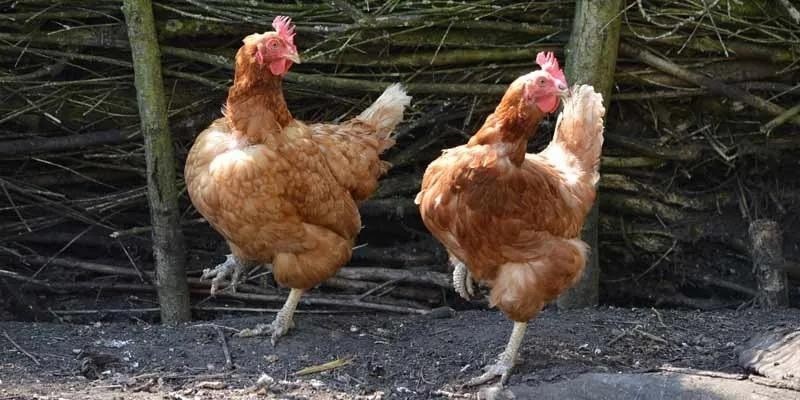There are a few reasons why chickens stand on one leg. Chickens are able to regulate their body temperature by standing on one leg. When they tuck the other leg up close to their body, they are conserving heat.
Chickens also stand on one leg to rest. Chickens have a lot of energy and are constantly on the move, so when they take a break, they like to perch on one leg to save energy. Chickens also stand on one leg to sleep.
When they tuck their head under their wing to sleep, they balance on one leg.
There are a few theories as to why chickens stand on one leg. Some say that it’s because they want to keep their other leg warm. Others say that they’re trying to balance their body so they don’t tip over.
Whatever the reason, it’s definitely a quirk of these interesting animals!
Chicken body language
When it comes to body language, chickens are interesting creatures. They communicate through a variety of sounds and body language cues. Here are some things to look for when trying to interpret what your chicken is saying:
Clucking: This is the most common sound made by chickens and is used for a variety of purposes, from greeting other chickens to getting their attention. Crowing: Chickens will crow when they are excited or happy, as well as when they feel threatened. Purring: Chickens will sometimes purr when they are content or affectionate.
Fluffing: When a chicken fluffs up its feathers, it is usually a sign that it is feeling cold or scared. Stretching: Chickens will often stretch their necks and wings when they first wake up or when they are getting ready to lay an egg. Head Bobbing: Head bobbing is a way for chickens to communicate dominance or aggression.
Wing Flapping: Wing flapping can be a sign of excitement, but it can also be used to intimidate other chickens. Eating Grass: Chickens will sometimes eat grass to help them digest their food properly. However, it can also be a sign that they are feeling anxious or stressed.
Chickens are fascinating creatures, and their body language is just one way to learn more about them.
Why is my chicken holding her leg up?

If your chicken is holding her leg up, it’s most likely because she’s in pain. Chickens are very good at hiding their injuries, so it’s important to keep an eye on them and look for any signs of distress. If your chicken is holding her leg up, it’s likely that she has an injured foot or leg.
The most common cause of an injured foot or leg in chickens is bumblefoot, which is an infection of the footpad. Bumblefoot is caused by a bacteria called Staphylococcus aureus, which is commonly found on the skin of humans and animals. The bacteria enter the chicken’s body through a cut or scrape on the foot, and can cause swelling, redness, and pain.
Bumblefoot can be treated with antibiotics, but it’s important to catch it early. If left untreated, bumblefoot can lead to amputation of the affected foot.
How to tell if a chicken has a broken leg?
If you have a chicken with a broken leg, there are a few things you can do to tell. First, check to see if the leg is hanging limply or if it is held close to the body. If the leg is held close to the body, it is likely not broken.
Second, check to see if the bone is protruding from the skin or if the skin is intact. If the bone is protruding, the leg is likely broken. Finally, check to see if the chicken is putting any weight on the leg.
If the chicken is not putting any weight on the leg, it is likely broken.
High stepping chicken

If you’re looking for a fun and festive way to add some excitement to your next chicken dish, try the high-stepping chicken! This unique cooking technique involves chicken that is fried or baked with a special breading that includes a variety of spices. The result is a chicken dish that is full of flavor and sure to please even the most discerning palate.
So, what exactly is high-stepping chicken? It’s chicken that has been coated in a breading that typically includes flour, cornmeal, salt, pepper, and paprika. This breading is then fried or baked, resulting in a crispy and delicious chicken dish.
One of the great things about high-stepping chicken is that it can be customized to suit your tastes. If you like your chicken spicy, simply add more paprika to the breading. Or, if you prefer a milder flavor, reduce the amount of paprika.
The beauty of this dish is that it can be made to suit anyone’s taste buds! If you’re looking for a fun and festive way to liven up your next chicken dish, give high-stepping chicken a try. You won’t be disappointed!
Chicken leg mites
If your chickens seem restless, have decreased energy, or are losing feathers, they may have chicken mites. These tiny pests are hard to see but cause big problems for chickens. Here’s what you need to know about chicken mites and how to get rid of them.
What are chicken mites? Chicken mites are tiny parasitic insects that feed on the blood of chickens. They are about the size of a pinhead and are reddish-brown in color.
Chicken mites are most active at night when they come out to feed. How do chickens get mites? Mites can hitch a ride into your chicken coop on wild birds, rodents, or even your clothes.
Once they’re in the coop, they quickly spread from chicken to chicken. What are the signs of chicken mites? The most common sign of chicken mites is restless behavior.
Chickens will often shake their heads and body to try to get rid of the mites. They may also have decreased energy and lose feathers. In severe cases, chickens can become anemic and die.
How do I get rid of chicken mites? The best way to get rid of chicken mites is to prevent them from coming into your coop in the first place. But if your chickens already have mites, there are a few things you can do to get rid of them.
What does it mean when a chicken is standing on one leg?
There are a few different theories as to why chickens stand on one leg. The most popular theory is that it’s a way for them to conserve body heat. Chickens are covered in feathers, which insulate them from the cold.
However, their legs are not covered in feathers. When they stand on one leg, they tuck the other leg close to their body, which helps to keep that leg warm. Another theory is that standing on one leg helps chickens to balance better.
Chickens have relatively large bodies and small heads. This can make it difficult for them to keep their balance. When they stand on one leg, they can use their other leg to help them stay upright.
Whatever the reason, chickens seem to enjoy standing on one leg. And, it’s not just chickens that do it. Many other birds, including storks and flamingos, often stand on one leg as well.
So, if you see a chicken standing on one leg, don’t be too surprised.
Why is my chicken holding its leg up?
If you’ve ever seen a chicken holding one of its legs up in the air, you may have wondered what’s going on. After all, it doesn’t look very comfortable. There are actually a few reasons why chickens hold their legs up, and it’s important to know what they are so that you can properly care for your chickens.
One reason why chickens hold their legs up is that they are injured. If a chicken is injured, it will often hold its leg up in an effort to protect the injury. This is especially true if the injury is on the foot or leg, as the chicken will not want to put any weight on it.
If you see a chicken holding its leg up, you should check for injuries and provide any necessary medical care. Another reason why chickens hold their legs up is that they are hot. Chickens don’t sweat, so they don’t have an efficient way to cool down when it’s hot outside.
Holding their legs up helps them to cool down by increasing air circulation around their body. If you see a chicken holding its legs up on a hot day, make sure to provide it with plenty of water to drink and a cool place to rest. Finally, chickens sometimes hold their legs up simply because they’re tired.
Chickens sleep with one eye open and one leg up, so it’s not uncommon to see a chicken holding its leg up during the day.
Why do some birds stand on one leg?
When you see a bird standing on one leg, it may look like the bird is resting or taking a break. However, there is actually a scientific reason behind this behavior. Birds have a difficult time regulating their body temperature, so they use different methods to stay cool.
One way is by panting, which is when they open their beaks and breathe rapidly. Another way is by standing on one leg. When a bird stands on one leg, the other leg is elevated and not in contact with the ground.
This helps to reduce heat loss from the body and keeps the bird cool. So the next time you see a bird standing on one leg, don’t think it’s just taking a break. The bird is actually trying to stay cool!
Do chickens recognize their owners?
Do chickens recognize their owners? The answer to this question is a resounding yes! Chickens are very intelligent creatures and are capable of forming strong bonds with their owners.
In fact, research has shown that chickens can even distinguish between different human faces and remember them for years to come. So, if you’re wondering whether or not your chicken knows who you are, the answer is most likely yes. Chickens are social creatures and enjoy spending time with their human companions.
So go ahead and give your chicken a little scratch under the chin – they’ll definitely appreciate it!
Why Do Flamingos Stand on One Leg?
Conclusion
The author of the blog post explains that there are several reasons why chickens stand on one leg. One reason is that it helps them stay warm. Chickens have a lower body temperature than other animals, so they need to find ways to stay warm.
Standing on one leg helps them conserve body heat. Another reason chickens stand on one leg is to conserve energy. When a chicken is standing on two legs, it is using more energy than when it is standing on one leg.
This is because the chicken has to use its muscles to balance itself. By standing on one leg, the chicken can relax its muscles and save energy. The third reason chickens stand on one leg is to keep their feet from getting wet.
Chickens have feathers on their feet that help keep them dry. If their feet got wet, the feathers would get soggy and the chicken would get cold. The author concludes by saying that there are probably other reasons why chickens stand on one leg, but these are the three most likely reasons.
Last Updated on January 14, 2025 by Pauline G. Carter

